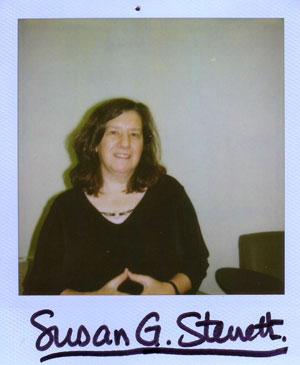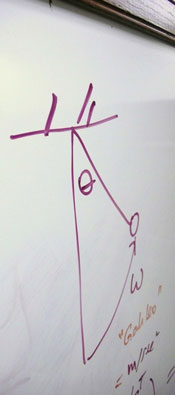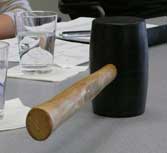::: center home >> being here >> last donut? >> similarity and dimensions |
Similarity and Dimensions We are now several weeks into the new term. We have lost a few fellows who were visiting only for the Fall term. In their place are new fellows. We met as a new group for the first time last week and snapped Polaroid photos of the new faces. Each said something about what they do and think about. The short speeches started as perfunctory rituals, humoring a demanding director. They soon turned into something more interesting. In a group this big, you might pass someone in the corridor for two months before finding out just how much you have in common. It's combinatorics at work. Seven scholars form 7x6/2 = 21 pairs. There are bound to be surprises. It is now Wednesday and we are meeting for our first reading. Susan Sterrett has provided the text. Natalie will present it and our new Fellow, Tad Szubka, will chair, wielding the mallet of authority. We nibbled flax seed taco chips and dip. Susan is interested in issues of methodology that receive much less attention in philosophical circles than they deserve. These are issues of scaling and dimensional analysis. If you build a small model of something--a boat propeller, an airplane wing, a dam--how do you scale up the model behavior to the real thing? The field of study that answers is dimensional analysis. It tells us that the properties of all physical systems can be described fully by relations between dimensionless numbers. So we can pass from the model to the real thing merely by matching up the values of their dimensionless numbers. Two structures of very different sizes may agree on these numbers. That is how small models can be so informative. The room divided into two groups. There were those who had never really been exposed to dimensional analysis and were politely listening to Susan's pleas that it was unjustly neglected by philosophers. Then there were those who knew something of field. They could see that the doubters needed to be "sold." First Meinard Kuhlmann and then I stood at the whiteboard and began to recount the standard example that everyone learns. How does the period t of pendulum vary with its length x? The problem has three variables, x, t and the gravitational constant g. We can form only one dimensionless number out of them: t2g/x. That meant that there is only one relation possible: this number is a constant. We immediately infer that the period varies inversely with the square root of the pendulum size. Ta-da!! The astonishing thing is that this one analysis applies to other cases. Without any further calculation, the same dimensionless number tells us that the distance bodies fall from Galileo's tower increases with the square of time. Ta-da!! Dimensional analysis seems to carry off epistemic miracles. The sense of wonder at its power still has not worn off over thirty years after I was first initiated into its mysteries as a young engineering student. But there really can be no epistemic wizardry. We began to tug at the curtain that might reveal the ordinary means hidden behind it that powered the trick. Susan, however, had become rather quiet. She was watching us like an indulgent parent supervising children who had become a little too fascinated by something shining. It was time for the adult perspective. "I've never really liked the pendulum example and have avoided using it." she explained quietly, "I don't like that it gives an equation. It's a special case." She was right. What dimensional analysis usually does is to reduce dramatically the number of independent variables in a problem to a smaller, more tractable number. Reducing them to just one, so that essentially no further analysis was needed, was a special case that may amuse the children but would ultimately mislead them. There was a great deal more to explore before Tad wielded the mallet for the last time. We adjourned to dinner. Yielding to your pleas, our resident foodie, Natalie, revealed that she thought Spice Island the best eatery in Oakland. That's where we went. John D. Norton |






